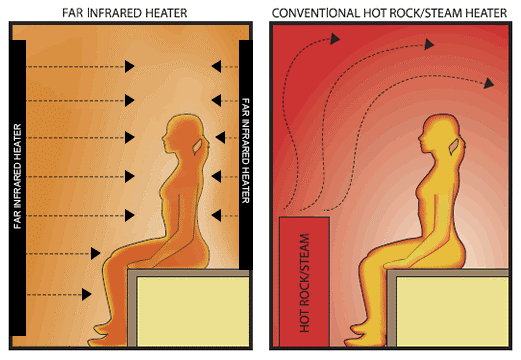The buzz about infrared sauna therapy is growing and they were really popular at the Bio Hacking Conference that was held recently in Los Angeles.
Do Infrared Sauna’s really Detox?
SWEAT-BASED therapies have been around for hundreds of years: The ancient Greeks and Egyptians loved to heat up in bathhouses; temazcal lodges were an integral part of indigenous communities in Mesoamerica; and in Finland, sauna-ing (the word “sauna” derives from the Finns) so pervades the culture that this nation of 5.5 million people harbors more than 3 million saunas.
Historically, heat treatments have been used to help heal the body for thousands of years. “Hot air baths” and sweat lodges were used for busting stress, increasing relaxation and detoxification.
Infrared sauna therapy, which involves exposing the body to radiant energy, emerged in mid-20th century Japan where doctors pioneered its use in the belief it could help heal wounds. Nowadays, infrared sauna spas are promoting the idea that the sweat you emit during a treatment will detoxify your body—eliminating heavy metals, radiation and environmental toxins.
Since this time, they have come a long way, and today they’re used by holistic practitioners and various healers around the world.
What are the benefits of Infrared Sauna’s?
While ongoing research is still being done to determine their long-term effects and potential benefits, as of now infrared sauna treatments seem to be safe, inexpensive and powerful. These small devices are proving to help many people suffering from pain feel better — and also very importantly, more relaxed!
Anti-aging effects, increased detoxification, pain reduction, joint and muscle support, and cardiovascular healing are currently where infrared saunas are gaining the most attention. They’re believed to have a parasympathetic healing effect, which means they help the body handle stress better — an attribute that could mean one day they’re used for handling all types of diseases from insomnia and depression to hormonal imbalances and autoimmune disorders.
The interesting thing about these types of saunas is that they differ from “regular saunas” because their light directly penetrates your skin but does not warm the air around you. The temperature in your body goes up quickly, yet the light has no effect on your surrounding environment — which is why you can use infrared saunas within your own home.
Are Infrared Saunas the New Hot Trend?
Infrared saunas are popular among the celebrity-set. At New York City’s Higher Dose, the spa that has helped popularize the sauna selfie, it’s common for friends to infrared in such a room together.
Detox claims aside, the stress-relief benefits appeal to those who dislike the blistering heat of a regular sauna, which can average between 150 to 175 degrees Fahrenheit; the heat of an infrared treatment, hovering around 120, feels less intense. “I’d always found both wet and dry saunas suffocating, but with infrared I almost don’t notice the heat until I start sweating 20 minutes in,” said Lesley Aitken, 54, a creative director in Los Angeles, who goes twice a week when her schedule permits.
How long is an Infrared session and how much does it cost?
You can undertake an infrared session in two ways: by slipping into a body-sized sauna wrap, made from non-porous vinyl, that envelops the body and allows you to comfortably recline (as one does at Shape House in Los Angeles); or by sitting in an enclosed private sauna room.
Modest folk can don a swimsuit; most clients, say spa owners, choose to go naked for 30-to-60 minute sessions. The average cost is between $50 to $65 an hour. If you love the effects then you can make the decision to buy your own personal sauna.
Some compare the experience to that of feeling your body heat up when you’re lazing in the sun on the beach. “Infrared is a gentler way to heat the body so you feel energized, not exhausted,” said Lauren Berlingeri, co-founder of Higher Dose. “It’s like a runner’s high.”
A lot of sweating should be expected, although it’s not painful and many people find it relaxing. Drinking water and getting plenty of rest are recommended. Most people don’t feel any different otherwise, although in some people with high levels of pain, report they feel an improvement almost immediately.
Are infrared sauna treatments safe?
“In general, sauna bathing—whether traditional or infrared—is felt to be safe,” said Dr. Haythe. “I always advise patients with medical problems such as heart disease and heart failure to discuss sauna bathing with their physician before beginning the practice.” New York City dermatologist Anne Chapas added another warning: “Patients with skin conditions like rosacea, melasma or acne may find they get worse with heat and sweating.” As do patients with a condition called anhidrosis.
Infra Red light is also considered “gentle radiant heat,” so although it can penetrate up to 1.5 inches (almost four centimeters) beneath the skin, it isn’t painful and doesn’t cause a burning effect.
That being said, it’s still a good idea to talk to your doctor or health care practitioner about starting treatments with infrared saunas if you have sensitive skin, a history of heart problems or take medications.
Have a healthy and happy week
Dr Pia










